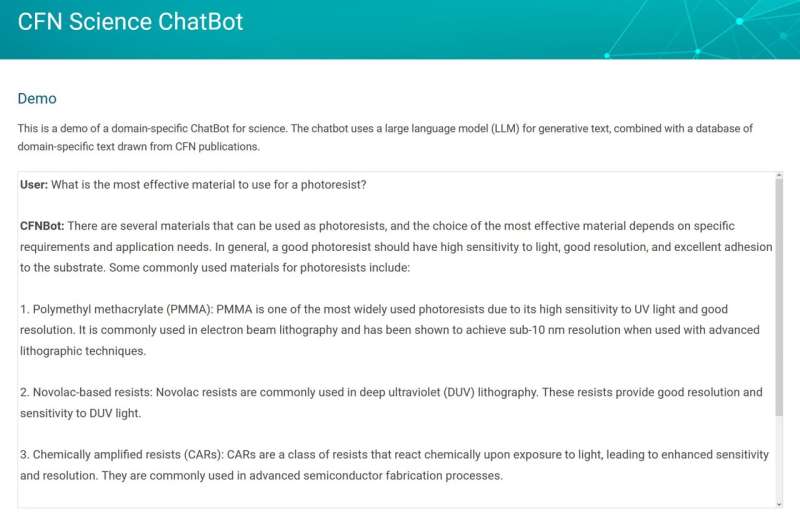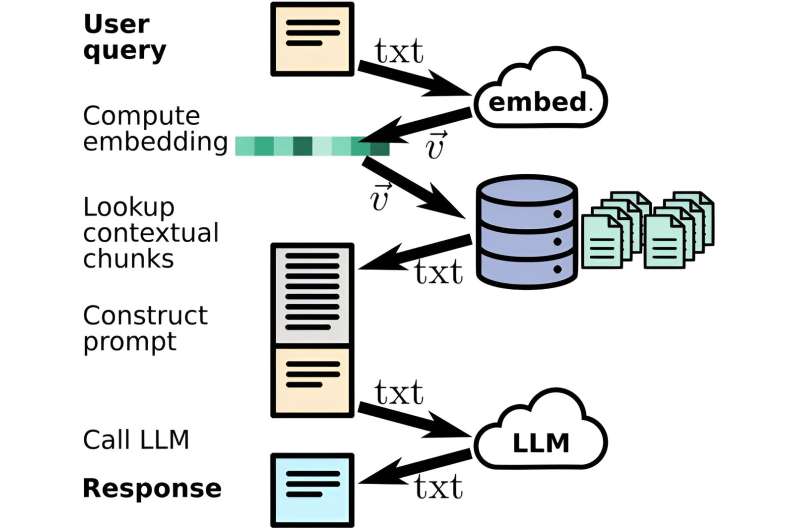A scientist has actually simply completed composing a clinical paper. She understands her work might gain from another point of view. Did she neglect something? Or possibly there’s an application of her research study she had not thought about. A 2nd set of eyes would be fantastic, however even the friendliest of partners may not have the ability to spare the time to check out all the needed background publications to capture up.
Quick advances in AI and ML have actually paved the way to programs that can produce innovative text and beneficial software application code. These general-purpose chatbots have actually just recently caught the general public creativity. Existing chatbots– based upon big, varied language designs– do not have comprehensive understanding of clinical sub-domains.
By leveraging a document-retrieval technique, Yager’s bot is educated in locations of nanomaterial science that other bots are not. The information of this job and how other researchers can take advantage of this AI coworker for their own work have actually just recently been released in Digital Discovery
Increase of the robotics
” CFN has actually been checking out brand-new methods to take advantage of AI/ML to speed up nanomaterial discovery for a long period of time. Presently, it’s assisting us rapidly determine, brochure, and pick samples, automate experiments, control devices, and find brand-new products. Esther Tsai, a researcher in the electronic nanomaterials group at CFN, is establishing an AI buddy to assist accelerate products research study experiments at the National Synchrotron Source Of Light II (NSLS-II).” NSLS-II is another DOE Workplace of Science User Center at Brookhaven Laboratory.
At CFN, there has actually been a great deal of deal with AI/ML that can assist drive experiments through using automation, controls, robotics, and analysis, however having a program that was proficient with clinical text was something that scientists had not checked out as deeply. Having the ability to rapidly record, comprehend, and communicate info about an experiment can assist in a variety of methods– from breaking down language barriers to conserving time by summing up bigger pieces of work.

Viewing your language
To construct a specialized chatbot, the program needed domain-specific text– language drawn from locations the bot is meant to concentrate on. In this case, the text is clinical publications. Domain-specific text assists the AI design comprehend brand-new terms and meanings and presents it to frontier clinical principles. Most notably, this curated set of files makes it possible for the AI design to ground its thinking utilizing relied on realities.
To imitate natural human language, AI designs are trained on existing text, allowing them to find out the structure of language, remember different realities, and establish a primitive sort of thinking. Instead of laboriously re-train the AI design on nanoscience text, Yager offered it the capability to search for pertinent info in a curated set of publications. Offering it with a library of pertinent information was just half of the fight. To utilize this text properly and efficiently, the bot would require a method to figure out the proper context.
” A difficulty that prevails with language designs is that in some cases they ‘hallucinate’ possible sounding however false things,” discussed Yager. “This has actually been a core concern to deal with for a chatbot utilized in research study rather than one doing something like composing poetry. We do not desire it to produce realities or citations. This required to be dealt with. The service for this was something we call ’em bed linen,’ a method of classifying and connecting info rapidly behind the scenes.”
Embedding is a procedure that changes words and expressions into mathematical worths. The resulting “embedding vector” measures the significance of the text. When a user asks the chatbot a concern, it’s likewise sent out to the ML embedding design to compute its vector worth. This vector is utilized to explore a pre-computed database of text portions from clinical documents that were likewise ingrained. The bot then utilizes text bits it discovers that are semantically connected to the concern to get a more total understanding of the context.
The user’s question and the text bits are integrated into a “timely” that is sent out to a big language design, an extensive program that produces text designed on natural human language, that produces the last reaction. The embedding makes sure that the text being pulled matters in the context of the user’s concern. By offering text portions from the body of relied on files, the chatbot produces responses that are accurate and sourced.
” The program requires to be like a referral curator,” stated Yager. “It requires to greatly depend on the files to supply sourced responses. It requires to be able to properly translate what individuals are asking and have the ability to efficiently piece together the context of those concerns to obtain the most pertinent info While the actions might not be ideal yet, it’s currently able to address difficult concerns and activate some intriguing ideas while preparing brand-new tasks and research study.”

Bots empowering people
CFN is establishing AI/ML systems as tools that can free human scientists to deal with more difficult and intriguing issues and to get more out of their minimal time while computer systems automate recurring jobs in the background. There are still lots of unknowns about this brand-new method of working, however these concerns are the start of crucial conversations researchers are having today to guarantee AI/ML usage is safe and ethical.
” There are a variety of jobs that a domain-specific chatbot like this might clear from a researcher’s work. Categorizing and arranging files, summing up publications, explaining pertinent details, and getting up to speed in a brand-new topical location are simply a couple of possible applications,” mentioned Yager. “I’m delighted to see where all of this will go, however. We never ever might have envisioned where we are now 3 years back, and I’m eagerly anticipating where we’ll be 3 years from now.”
For scientists thinking about attempting this software application out on their own, the source code for CFN’s chatbot and associated tools can be discovered in this GitHub repository
More info: Kevin G. Yager, Domain-specific chatbots for science utilizing embeddings, Digital Discovery ( 2023 ). DOI: 10.1039/ D3DD00112A